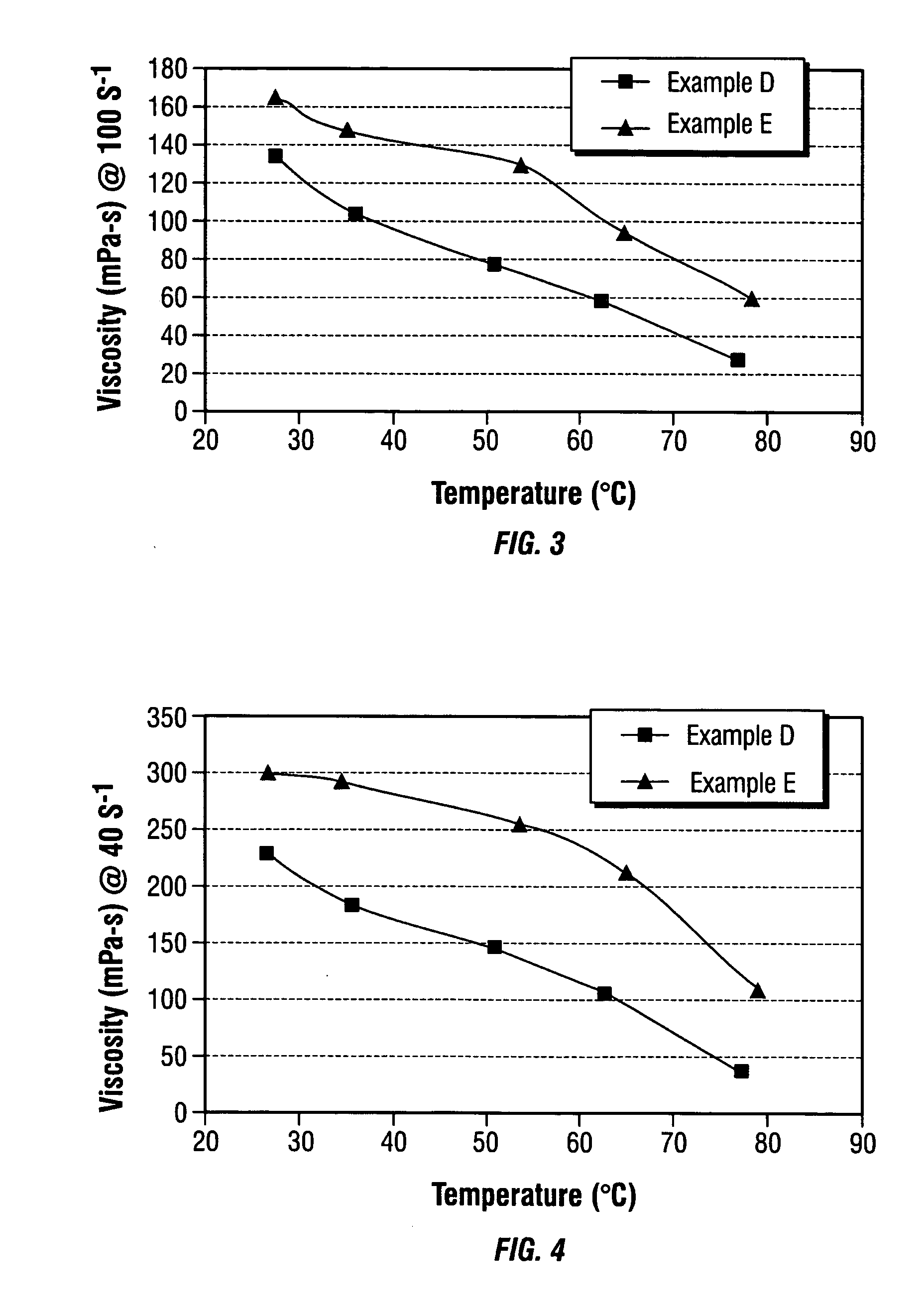Viscoelastic fluids containing nanotubes for oilfield uses
a technology of viscoelastic fluids and nanotubes, which is applied in the direction of sealing/packing, chemistry apparatus and processes, and well accessories, etc., can solve the problems of difficult handling or placement, low viscoelastic fluids use limit, and the use of micellar viscoelastic fluids for fracturing high permeability formations, etc., to achieve the effect of decreasing the viscosity of the fluid
- Summary
- Abstract
- Description
- Claims
- Application Information
AI Technical Summary
Benefits of technology
Problems solved by technology
Method used
Image
Examples
examples a
, B, and C
[0071] Using a 1 liter warring blender, 300 ml of the following viscoelastic surfactant fluid was prepared and then divided into three 100 ml portions.
IngredientWeight %Propane-1,2-diol0.3%Propan-2-ol0.4%Water (aqueous medium)98.1%Eurycyl (Z)-13 Docosenyl-N-N-1.2%bis (2-Hydroxyethyl) MethylAmmonium Chloride
[0072] To a first 100 ml portion, 0.1% by weight single walled carbon nanotubes, available from Carbon Nanotechnologies Incorporated, was added to and blended for 2 minutes under low speed to prepare example A. To a second 100 ml portion, 0.2% by weight of the same carbon nanotube was added to and blended for 2 minutes under low speed to prepare example B. A third portion, was left untreated to form a control, example C. Then, mixtures underwent 80 minutes of sonication (all samples were sonicated for the same time to ensure that there is no artifact due to sonication). Then, 3% by weight of NH4Cl was added to all three examples, A, B and C. The viscosity was then meas...
examples d and e
[0074] In a 1 liter warring blender, 200 ml of the following viscoelastic surfactant fluid was prepared and then divided into two 100 ml portions.
IngredientWeight %Propane-1,2-diol0.3%Propan-2-ol0.4%Water (aqueous medium)98.1%Eurycyl (Z)-13 Docosenyl-N-N-1.2%bis (2-Hydroxyethyl) MethylAmmonium Chloride
[0075] To a first 100 ml portion, 4% KCl was added to form example D. To a second 100 ml portion, 0.2% by weight single walled carbon nanotubes was added to and blended for 2 minutes under low speed, and then 4% KCl was added to prepare example E. Then, both mixtures underwent 80 minutes of sonication. The viscosity was then measured on a Fann 50 rheometer over several conditions.
[0076]FIG. 3 and FIG. 4 show the viscosity properties of viscoelastic surfactant fluid examples D and E as measured over a range of temperatures and at shear rates of 100 s−1 and 40 s−1. The data shows significant viscosity increase at like temperature when the carbon nanotubes are incorporated. Comparing e...
examples f
and G
[0077] To prepare samples F and G, 200 ml of the following viscoelastic surfactant fluid was prepared via warring blending and the separated into two 100 ml portions.
IngredientWeight %Isopropanol0.5Sodium Chloride0.2Water48.3Erucic amidopropyl1.0dimethyl betainePropane-1,2-diol0.1Propan-2-ol0.1Water (aqueous medium)49.6Eurycyl (Z)-13 Docosenyl-N-N-0.2bis (2-Hydroxyethyl) MethylAmmonium Chloride
[0078] 6% KCl was added to a first 100 ml portion in order to make example F. To a second 100 ml portion, 0.2% by weight single walled carbon nanotubes was added to and blended for 2 minutes under low speed, and then 6% KCl was added to prepare example G. Then, both mixtures underwent 80 minutes of sonication. The viscosity was then measured on a Fann 50 rheometer over several conditions.
[0079]FIG. 5 and FIG. 6 illustrate in graphic form, the viscosity properties of viscoelastic surfactant fluid examples F and G. The data shows significant viscosity increase with incorporated of carbon...
PUM
| Property | Measurement | Unit |
|---|---|---|
| Fraction | aaaaa | aaaaa |
| Fraction | aaaaa | aaaaa |
| Fraction | aaaaa | aaaaa |
Abstract
Description
Claims
Application Information
 Login to View More
Login to View More - R&D
- Intellectual Property
- Life Sciences
- Materials
- Tech Scout
- Unparalleled Data Quality
- Higher Quality Content
- 60% Fewer Hallucinations
Browse by: Latest US Patents, China's latest patents, Technical Efficacy Thesaurus, Application Domain, Technology Topic, Popular Technical Reports.
© 2025 PatSnap. All rights reserved.Legal|Privacy policy|Modern Slavery Act Transparency Statement|Sitemap|About US| Contact US: help@patsnap.com



